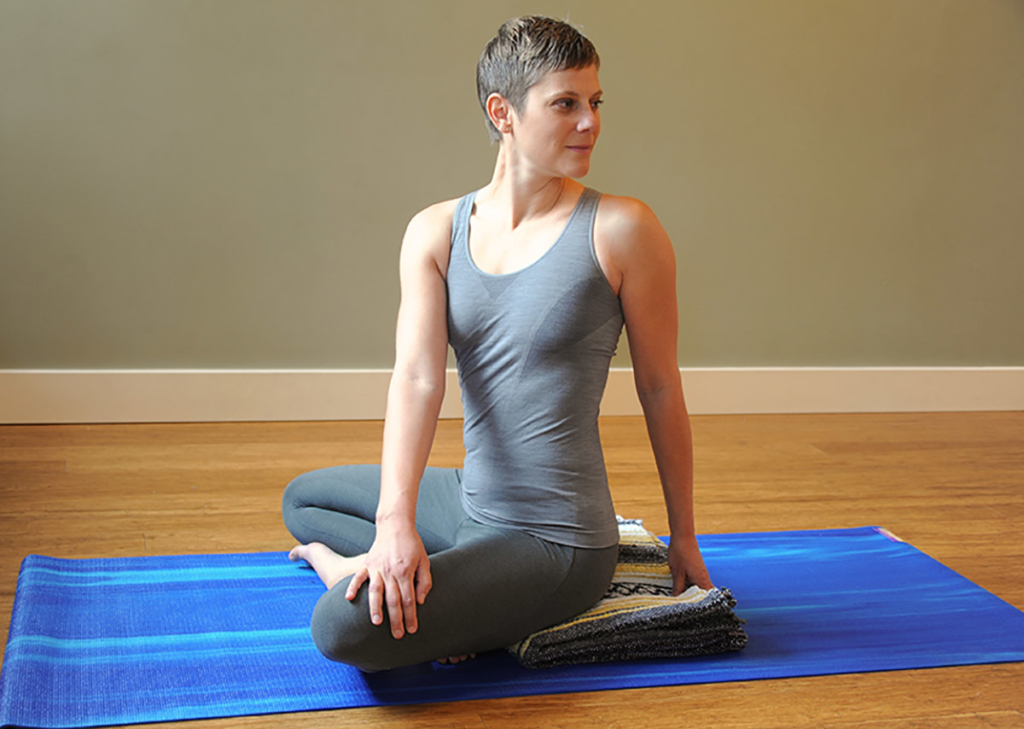This entry was posted on Jul 24, 2024 by Charlotte Bell.

There’s been a lot of debate in the blogging/social media world about what yoga is and is not. Popular yoga is often seen as a sped-up version of yoga asanas (postures). While a smaller, but just as vocal, camp see yoga as a whole system that includes meditation and daily life practice. As a yoga practitioner of more than 40 years, I fall into the second group. If I had to pick one aspect as the most basic foundation of yoga, I’d choose ahimsa.
Ahimsa is the first of the yamas, which comprise the first of yoga’s eight limbs, according to the yoga sutras. The yamas are moral/ethical guidelines for living consciously. Ahimsa is usually defined as non-harming. That’s a good start, but it’s more than that. Sutra scholar Alistair Shearer calls it “dynamic peacefulness.”
I love this definition. Instead of simply avoiding harm, the phrase suggests active participation in living a peaceful life. For me, it also implies a cultivated state of inner peace. We can act from this inner state of peace in our yoga practice and in our lives.
Ahimsa on the Yoga Mat
We can practice ahimsa on or off the mat. Here are some ways to explore ahimsa on the mat:
Check Your Judgments
We all come to yoga practice with certain genetic and habitual physical qualities. Some of the qualities are conducive to certain poses. Some of them might hinder our ability to practice some poses. We are all different. Comparing yourself to others in the class can take the joy and spontaneity out of your yoga. Notice the times when you judge yourself in comparison to others—positively or negatively. (Then take care not to judge yourself for judging!) Notice how it feels. Instead, tune in to your internal experience in the pose. What can you learn?
Check Your Breathing
Ultimately, our yoga practice should replenish our energies. But quite often, pushing and striving on the mat can actually deplete our energies. The most reliable way I’ve found to monitor my effort is to check in with my breathing. If I’m practicing at my intelligent edge, my breathing will be relaxed and deep. If I’m pushing up against my body’s limits, my breathing will feel shallow and restricted. Breathing deeply in yoga postures is what allows us to feel that incomparable calm energy after we finish Savasana (Relaxation Pose). If your breathing is restricted, back off and do less.
Check Your Stretching
Yoga is most effective when we follow a “less is more” strategy. Western culture loves intensity and the “no pain, no gain” mentality. That’s not what asana practice is about. Pain is a signal that we may be causing harm. Aim for a mild to moderate stretch, one that gives you room to explore.
Cultivating Dynamic Peacefulness
Ahimsa off the mat is a huge practice. You could spend the rest of your life just focusing on this single yama. In my book, Mindful Yoga, Mindful Life, I go into much more detail about some of the ways of practicing ahimsa, but here are a few ideas:
Think Before You Act
The tricky thing about ahimsa is that non-harming action can differ depending on the situation. Let go of evaluating actions as “good” or “bad.” Instead, as you consider taking an action, ponder whether you believe your action has potential to cause harm or to bring happiness. Also, ponder your intentions. Are you considering taking action out of anger, greed, jealousy or some other unskillful mental state? Or are you taking action out of compassion, kindness, generosity or some other skillful state? Mindful speech is a huge area of exploration. Here are some ideas for refining your speech.
Cultivate Dynamic Peacefulness
When our actions are aligned with our integrity, and our choices are skillful, we naturally feel more peaceful. So practicing the above suggestion can go a long way toward cultivating dynamic peacefulness. But we can do this in our meditation and yoga practice as well. You can practice the above “Ahimsa on the Yoga Mat” suggestions. You can also take time to practice mindfulness and kindness meditations. Ultimately, we want the state of dynamic peacefulness to be where we are coming from, so that ahimsa guides our actions naturally.
Consider Your Choices
We can express ahimsa in our lifestyle choices. For example, we can choose to buy products that are friendly to the Earth. Or we can choose whether or not to eat animals. This is a tricky one, often fraught with judgment. For some of us, the choice is easy because going meatless feels good. For others whose bodies thrive on animal products, the ahimsa-informed choice might be to consume meat. To start, pick one area that you feel passionate about—living small, getting involved in charitable causes, being available to struggling friends or family members. There are lots of ways to cultivate dynamic peacefulness in your life. What do you feel passionate about?
Please let us know how you cultivate ahimsa, on and off the mat.
About Charlotte Bell
Charlotte Bell discovered yoga in 1982 and began teaching in 1986. Charlotte is the author of Mindful Yoga, Mindful Life: A Guide for Everyday Practice and Yoga for Meditators, both published by Rodmell Press. Her third book is titled Hip-Healthy Asana: The Yoga Practitioner’s Guide to Protecting the Hips and Avoiding SI Joint Pain (Shambhala Publications). She writes a monthly column for CATALYST Magazine and serves as editor for Yoga U Online. Charlotte is a founding board member for GreenTREE Yoga, a non-profit that brings yoga to underserved populations. A lifelong musician, Charlotte plays oboe and English horn in the Salt Lake Symphony and folk sextet Red Rock Rondo, whose DVD won two Emmy awards in 2010.

